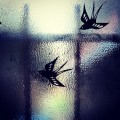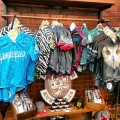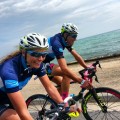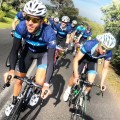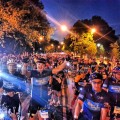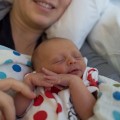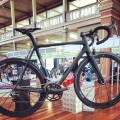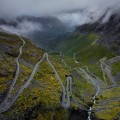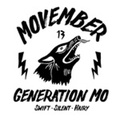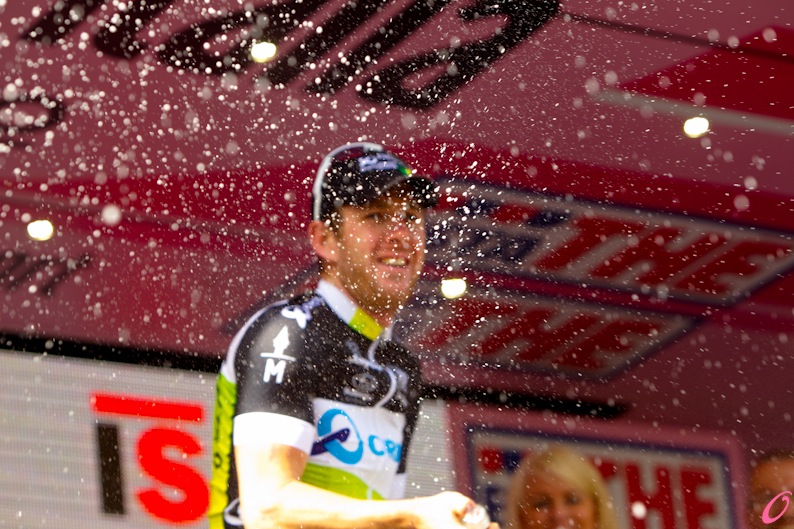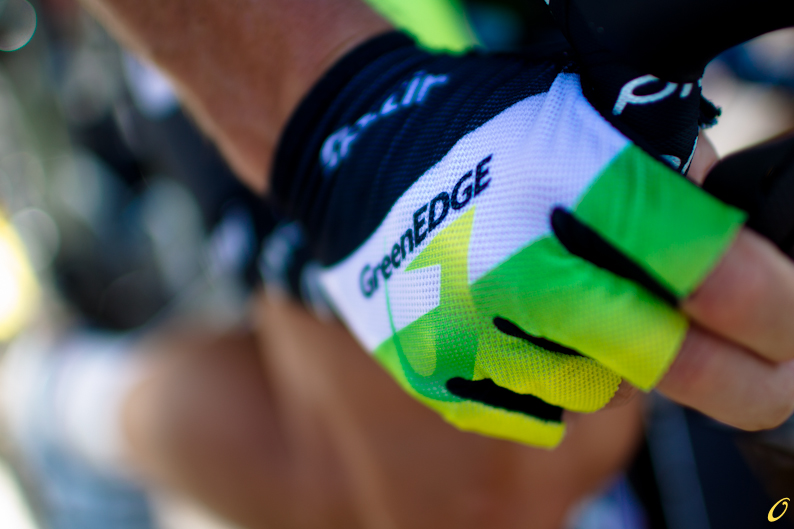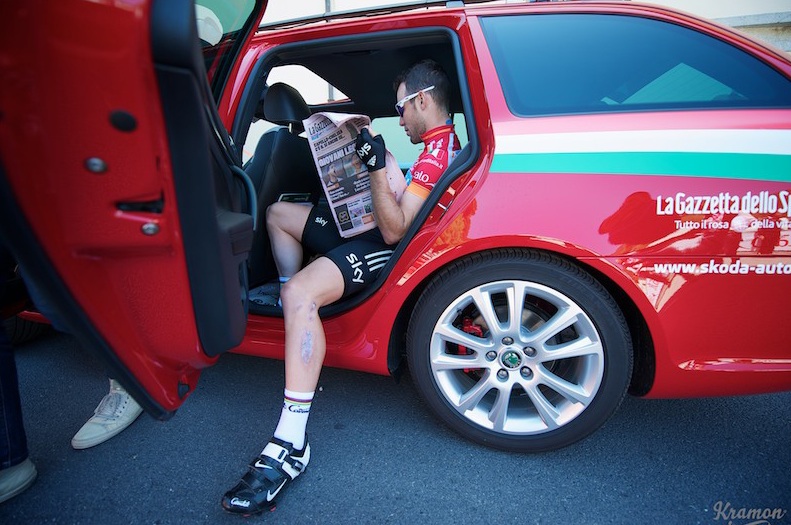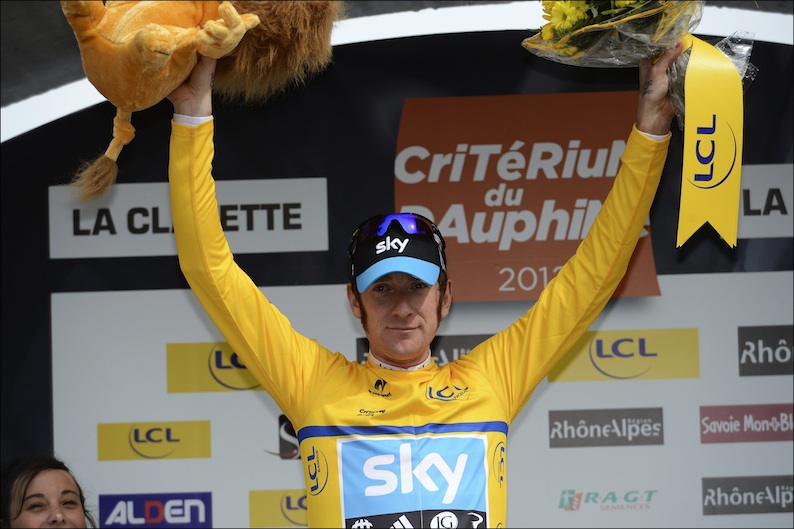Garmin’s romp, from the time trial to the maglia rosa
Garmin proved the importance of time trial strength in Verona. It capitalised on its placings in the opening time trial, won the team time trial and placed little-known Ramunas Navardauskas in the overall lead. That ride also set up Ryder Hesjedal for an overall run, Canada’s first in the pink jersey.
“I don’t know what else to say,” Navardauskas said of his first day in the lead.
“As a child, you dream to be a cyclist, you want to be a good, you want to be a pro… It all comes true. Then you want to win something. To have this jersey means I really proved myself.”
The American team crushed surprise rival, Katusha. It posted a time of 37’04″, five seconds faster. Orica placed sixth at 25″.
Navardauskas added, “I’m lucky to have a team that allowed me to do this.”
Team Garmin won the Tour of Qatar time trial in February, but, more importantly, it won in Grand Tour tests. It took the time trial in the Giro d’Italia in 2008 and the Tour de France last year. Each time, the leader’s jersey came along with the win.
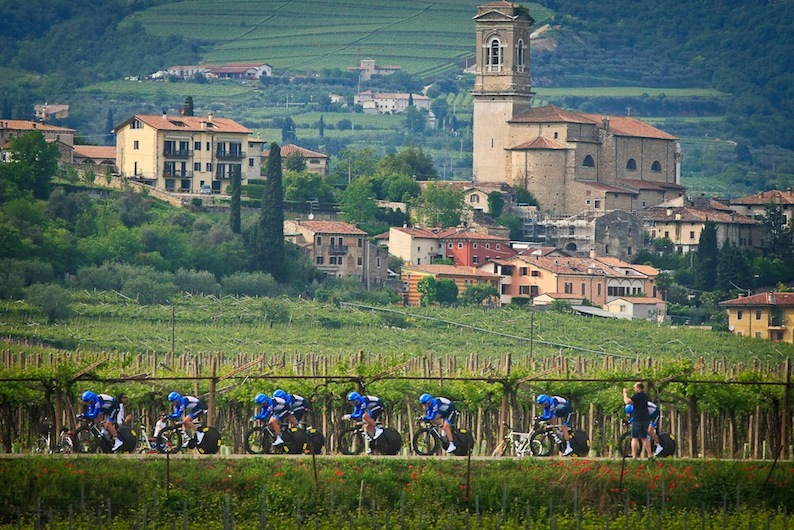
Garmin – Barracuda riding the fastest TTT of stage 4. Photo: Cor Vos
In the opening time trial, it placed five of its nine riders in the top 20. Hesjedal placed 17th, hovered close to the top of the GC and, on Saturday, took the overall lead in Rocca di Cambio in Abruzzo. He explained, “This is definitely the product of perfect team work and a strong team.”
The time trials in Herning and Verona were the key to Garmin’s pink jersey run. The Verona stage simply translated its gains from the opening day to pink.
Garmin DS, Allan Peiper explained, the time trial “is a thing we try to excel at because we want to be a team and function as a team. This team has been talking about this time already since the Giro presentation last year.”
It spent five days in pink, two with Navardauskas and three with Hesjedal. Today, Hesjedal lost the overall lead to Joaquím Rodríguez (Katusha).
“I’m completely satisfied, three days in the jersey, defending… It’s been amazing,” Hesjedal explained. “I’ve got no problems giving it up to Rodríguez and carrying on with the race.”
Welcome to the club
Ryder Hesjedal, the first Canadian in the Maglia Rosa until the end of stage 10. Photo: Veeral Patel
Navardauskas and Hesjedal became the first from their countries, Lithuania and Canada, to wear the maglia rosa. They’re the 21st and 22nd different countries in pink.
Cadel Evans gave Australia its first in 2002. In 1988, after the snowy and icy stage to over the Gavia, Andy Hampsten became the first non-European, and US rider, to wear the top. He won the race a few days later. Alexander Vinokourov became the first Asian in 2010.
Frenchman Jean Dortignac became the first foreigner leader of the race on May 20, 1910, in Bologna. The pink jersey only came about in 1931.
Hesjedal said that he’s making his country proud. “They are going to know a lot about it [the Giro] now.”
One for the other guys
Miguel Rubiano, the 27 year old climber from Colombia first major win.
Over the weekend, cycling’s lesser-lights won in the Giro d’Italia’s mid-mountain stages. Miguel Rubiano (Androni) won in Porto Sant’Elpidio, Paolo Tiralongo (Astana) in Rocca di Cambio and Domenico Pozzovivo (Colnago-CSF Inox) in Lago Laceno.
“It’s okay considering we face a week without a rest day, which ends with two hard stages. After that, the usual Giro where you can’t let your guard down,” Roman Kreuziger (Astana) said. “That doesn’t mean we just let Pozzovivo go, he had good legs and it was impossible to bring him back. He took advantage of the situation, his team didn’t do well in the TT, if it had, he would not have been allowed that freedom.”
Kreuziger said it was good that team-mate Tiralongo won in Rocca di Cambia so that he took the maximum bonus points from rival Michele Scarponi (Lampre-ISD).
Rubiano and Pozzovivo both ride for second division, Italian teams. The wins will have made their season a success.
Cavendish’s ups and downs
World Champion Mark Cavendish won twice so far in the Giro d’Italia, but has crashed just as much. In Horsens last Monday and in Frosinono this Monday, the Sky rider was prevented from spreading his wings.
On Monday, Francisco Ventoso (Movistar) won thanks to surviving the final bend. Matt Goss (Orica) and Filippo Pozzato (Farnese Vini) crashed, holding up Cavendish and others.
“I wasn’t easy,” Ventoso said. “However, without the crash, I couldn’t have done it.”
Pozzato abandoned the race over night with a broken bone in his right hand. Yesterday morning, he went to the start and spoke with Cavendish on the bus. At the sign in, he spoke with the press.
“The difficulty of the curve was written in the race book,” Ventoso added. “It’s not like the organisers can have a straight, five-kilometre run every day.”
Ahead of the corner at 350 metres out, Cavendish seemed to be placed far back and without team-mates.
“It’s not the first time that he had his team work 50-60km from the finish and then he wasn’t able to stay on the train,” sprint legend, Mario Cipollini told La Gazzetta dello Sport. “Even when he’s won, he didn’t take advantage of his team very well.”
Cavendish didn’t comment to the media on the crash after the stage on Monday, but tweeted:
Sprinters heading home
Several of Cavendish’s rivals have already abandoned the Giro. Thor Hushovd (BMC Racing) left feeling tired, Tyler Farrar (Garmin-Barracuda) crashed on Saturday, Daniele Bennati (RadioShack-Nissan) suffered from a fever and Romain Feillu (Vacansoleil-DCM) suffered from crashes in Denmark.
Besides Goss, Mark Renshaw (Rabobank), Juan José Haedo (Saxo Bank), Robert Hunter (Garmin-Barracuda) and Sacha Modolo (Colnago-CSF Inox) are Cavendish’s main rivals.
The other classifications
Every day, riders fight for the pink, blue, red and white jerseys, but there are other classifications up for grabs. The Giro d’Italia is known for its pioneering ideas, like the Intergiro classification that awarded the classification for the best placed rider at the mid-way point each day. It faded away, but below are this year’s oddities:
Stage Combativity:
1 Miguel Minguez Ayala (Euskaltel-Euskadi) 21pts
2 Mark Cavendish (Sky) 19
3 Matthew Goss (Orica-GreenEDGE) 16
“Fuga Pinarello”
1 Miguel Minguez Ayala (Euskaltel-Euskadi) 475km
2 Martijn Keizer (Vacansoleil-DCM) 458
3 Reto Hollenstein (NetApp) 344
Intermediate Sprints:
1 Martijn Keizer (Vacansoleil-DCM) 15
2 Miguel Minguez Ayala (Euskaltel-Euskadi) 11
3 Olivier Kaisen (Lotto-Belisol) 8
Super team:
1 Garmin-Barracuda 213pts
2 Orica-GreenEDGE 144
3 Katusha 134
Azzurri d’Italia:
1 Matthew Goss (Orica-GreenEDGE) 8
2 Mark Cavendish (Sky) 8
3 Joaquím Rodríguez (Katusha) 5
Time gaps:
1 Liquigas-Cannondale
2 Astana 1’03″
3 Movistar 1’32″
Fair Play:
Garmin-Barracuda, Katusha, Astana, Liquigas-Cannondale, Lampre-ISD, AG2R-La Mondiale and FDJ-BigMat all at 0 points
Giro d’Italia to race Galibier
The Giro d’Italia will end one of its stages next year up the Galibier in France, according to Italy’s Tuttosport newspaper. Andy Schleck won there last year, when the Tour de France visited.
Tuttosport also reported the start and general direction of the race. The Giro will start in Naples, in Italy’s south with a team or individual time trial. The race will travel along the west coast and then head over to Puglia, Italy’s heel.
The race will head to Vincenzo to celebrate Tullio Campagnolo, who died 30 years ago. Along the way, it will also visit Florence and race along the 2013 Worlds parcours.
The newspaper suggested that the Gavia and the Tre Cime di Lavaredo would also feature. However, the Galibier will set the race apart. This year, the Giro wanted to visit the Alpe d’Huez to celebrate 60 years since Fausto Coppi won on its first inclusion in the Tour. The organisers determined it was too far into France and might see the Galibier as a nice compromise.
The Giro will announce the parcours in the autumn.
Ullrich admits mistakes
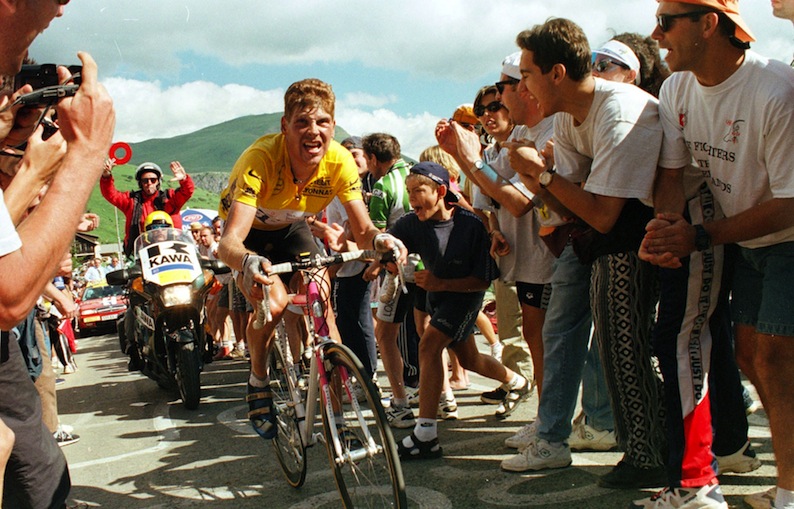
Jan on his way to winning his first and last Tour de France in 1997. Photo Cor Vos
Jan Ullrich revealed some of his doping past in his online column for German EuroSport. The German 1997 Tour de France winner was recently banned for doping.
“No doubt that several doping cases in recent years have hurt. I have also made my mistakes. But my case is finished. And years of despair, depression and physical problems are finally over,” Ullrich wrote.
“Cycling has lost none of its charm. There are many young riders who will not make the same mistakes as the older generation.”
In February, Sport’s High Court, CAS, ruled he had connections to doping doctor, Eufemiano Fuentes. It stripped him of his wins, including second at the 2005 Tour, and suspended him for two years.
The case stemmed from the 2006 doping investigation, Operación Puerto. Spanish investigators linked Ullrich and many others to Fuentes as part of Operación Puerto. They found over 200 coded blood bags when they raided Fuentes’ offices in May 2006, some containing EPO and all ready to be transfused back into their owners. Ullrich kept competing and won the Tour de Suisse, but it was his last race as he was barred from the 2006 Tour.
He said he would write about team-work and tactics in his next EuroSport column.
Sagan back to his winning ways in California
Peter Sagan (Liquigas-Cannondale), after a short break following the Ardennes Classics, is back to his winning ways in the Tour of California. He’s won all three stages so far ahead of Heinrich Haussler (Garmin-Barracuda) in each.
“So far, I have won two for two, but it can’t always be a party,” Sagan said yesterday in a press release. “Truth is, I like racing here in California, I like this race a lot. The more relaxed you are, the easier it is to carry out your plans.”
Peter Segan on the podium after winning stage 2 of the Tour of California. Photo Cor Vos
The 22-year-old Slovakian has been winning consistently since turning pro in 2010: Stages in Paris-Nice, the Vuelta a España, the Tour of California, Romandy, Switzerland, Poland and Oman. Before his break and California, he won a stage in the Three Days of De Panne and placed third in Amstel Gold.
The Tour of California:
1: May 13, Santa Rosa, 186.5km
2: May 14, San Francisco - Santa Cruz, 188.5km
3: May 15, San Jose - Livermore, 185.5km
4: May 16, Sonora - Clovis, 209.6km
5: May 17, Bakersfield ITT, 29.7km
6: May 18, Palmdale - Big Bear Lake, 186.3km
7: May 19, Ontario - Mt. Baldy, 126.0km
8: May 20, Beverly Hills - Los Angeles Criterium, 72.0km
